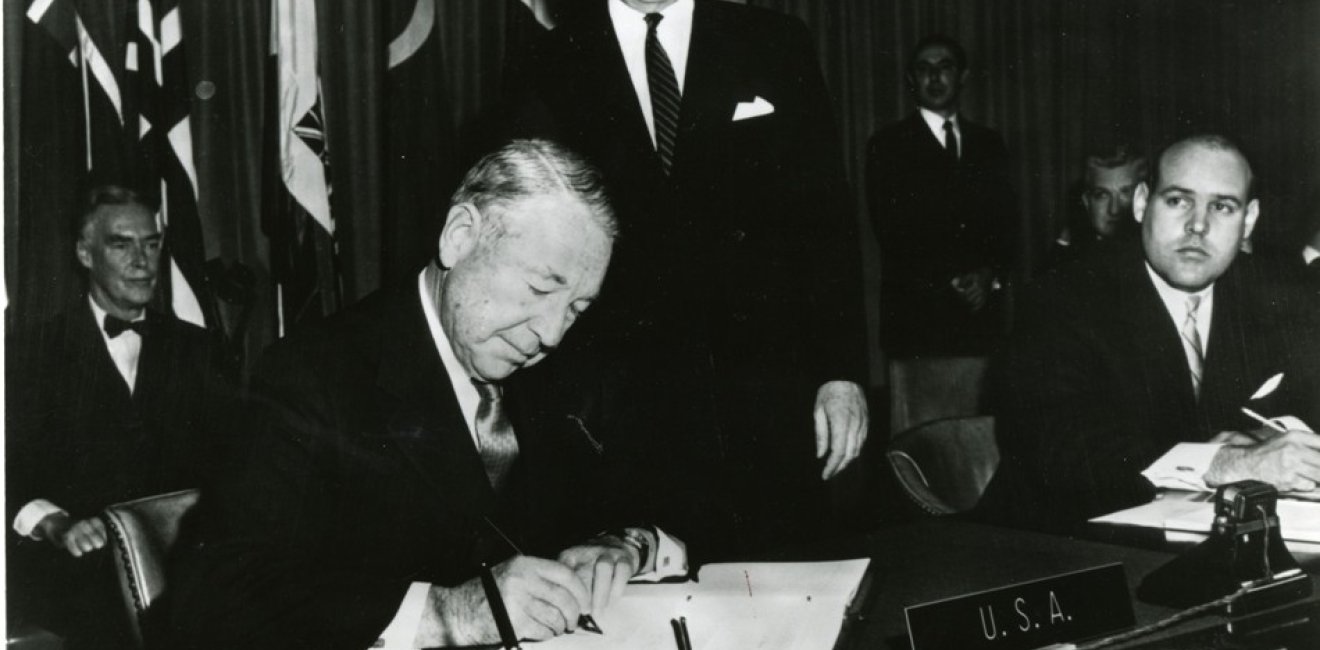Antarctic Arms Control at 60: A Precedent or a Pole Apart?
Sixty years ago this month, the 1959 Antarctic Treaty opened for signature. Ryan Musto revisits the history of this arms control agreement and its relevance for the Arctic today.

A blog of the History and Public Policy Program
Sixty years ago this month, the 1959 Antarctic Treaty opened for signature. Ryan Musto revisits the history of this arms control agreement and its relevance for the Arctic today.

Sixty years ago this month, the 1959 Antarctic Treaty opened for signature and became a landmark arms control agreement. The Treaty preserved Antarctica’s non-militarized status, making it the first and only demilitarized continent in the world. With its ban on nuclear weapons, nuclear testing, and “peaceful nuclear explosions” (later dubbed “PNEs”), the Treaty also made Antarctica the first denuclearized zone in the world.[1] To ensure these provisions, it pioneered a verification system that allowed for inspections anywhere and at all times.
The United States spearheaded the Antarctic Treaty negotiations in the late 1950s in part because of a fear that the Soviet Union might soon deploy nuclear weapons in the world’s southernmost continent. But as the most powerful nuclear power of the day, the United States did not wish to tie itself to provisions for arms control in Antarctica’s icy expanses that it might oppose elsewhere. Given the continent’s isolation, the Eisenhower Administration liked that provisions for Antarctic arms control would seemingly “not influence [broader] disarmament negotiations, either favorably or unfavorably.”
And yet the potential for Antarctic arms control as precedent appealed to an array of officials involved in the Antarctic Treaty negotiations. Argentina’s delegation, which had done more than any to secure a ban on PNEs, rejoiced that the Antarctic Treaty established “principles and precedents of historical significance” in the nuclear field that went “beyond the greatest expectations.” South Africa’s delegation lauded the Antarctic Treaty’s potential to free the rest of the world “from the destructive threat of war.”
Even Herman Phleger, the head US delegate, came around to the idea. Phleger testified before Congress that the Antarctic Treaty constituted “a precedent in disarmament, prohibition of nuclear weapons, and the law of space.” He believed that it would “prove a valuable source of practical experience” in inspections, and that the United States would lose credibility if it rejected the Antarctic Treaty but continued to call for verified arms control elsewhere.
Antarctic arms control helped to inspire later arms control agreements, especially in other uninhabited areas. In near identical language, the 1967 Outer Space Treaty emulated the Antarctic Treaty to ban nuclear weapons, “military bases and fortifications,” “military maneuvers,” and “the testing of any types of weapons.”
Likewise, Soviet and US officials identified the Antarctic Treaty as a practical and important precedent for the 1971 Seabed Treaty that denuclearized the ocean floor outside a twelve-mile coastal radius. More broadly, various dipomats and journalists credited the Antarctic Treaty with ushering in an era of geographic arms control and helping to “create the foundations of confidence” that sparked momentous arms control agreements in the 1960s, such as the 1963 Limited Test Ban Treaty and the 1968 Non-Proliferation Treaty.
But regional differences could limit specific adaptations of the Antarctic model. For outer space, the United States sought the Antarctic Treaty’s unrestrained verification, but the Soviet Union successfully countered that safety concerns necessitated reciprocal, pre-approved inspections. For the seabed, the Soviet Union sought demilitarization akin to the Antarctic Treaty, but the United States successfully limited it to denuclearization by arguing that it would be easier to enforce and still address the greatest threat to the region. Such limitations also extended to inhabited regions. In Latin America, diplomats dismissed the Antarctic Treaty as having denuclearized an area “of eternal snow,” whereas their 1967 agreement denuclearized a densely populated area.
Exploring the history of Antarctic arms control as precedent raises an important question: Can it serve as a model for other regions moving forward?
The most attractive recipient would seemingly be Antarctica’s polar opposite, the Arctic. Like Antarctica, the Arctic is an icy region at the ends of the earth that plays a critical role in regulating the global climate.
The idea of transferring Antarctic arms control to the Arctic has existed since the advent of the Antarctic Treaty, with one US editorial in late 1959 claiming that such an arrangement would make it “considerably more difficult for Russia and the United States to shoot intercontinental missiles at each other.” More recently, New Zealand’s former Minister for Disarmament and Arms Control asserted that, “The Arctic must be declared a Nuclear-Weapon-Free Zone for the sake of humanity, for the sake of the world’s ecosystem. The wheel does not have to be reinvented. The model to achieve this goal exists in the Treaty of Antarctica…”[2]
But applying Antarctic arms control to the Arctic is easier said than done. Unlike Antarctica, the Arctic covers Russian and US territory, raising difficult issues of sovereignty for two nuclear superpowers. Moreover, the Arctic is already militarized, with Russian and US nuclear submarines having patrolled its waters for decades. As climate change melts the ice around the Arctic Ocean, new sea lanes will open and resources like oil and gas will become increasingly accessible. In response, Russia and the United States have heightened their military operations in the region, while China looks to secure shipping routes along a “Polar Silk Road” and could one day deploy nuclear submarines to Arctic waters as a deterrent.[3]
Antarctic arms control appears ill-suited for such circumstances. The Antarctic Treaty froze a demilitarized continent in place, and while the Treaty reaches to 60 degrees south parallel to incorporate the Southern Ocean, it defers to international maritime law that allows for nuclear transit.[4] Meanwhile, the Antarctic Treaty pioneered international governance for the region, but a similar system in the Arctic would have to overcome existing arrangements. The Arctic Council, a forum for cooperation amongst eight regional states and six indigenous organizations, is not allowed to address military matters.[5] Moreover, the 2008 Ilulissat Declaration issued by five Arctic states (including Russia and the United States) asserted that there was “no need to develop a new comprehensive international legal regime to govern the Arctic Ocean,” a clear rejection of any “Arctic Treaty” based on the Antarctic model.[6]
It will be difficult to apply Antarctic arms control to the Arctic. But even adherence to the spirit of the Antarctic Treaty, which prioritizes peaceful coexistence, would benefit the region. On the day the Antarctic Treaty opened for signature, President Eisenhower lauded the agreement as “a significant advance toward the goal of a peaceful world with justice.”[7] The Arctic, along with other regions, would do well to strive towards a similar achievement.
[1] The Treaty still allowed for the peaceful uses of nuclear energy.
[2] The preceding text is adapted from Ryan A. Musto, “Antarctic arms control as precedent,” Polar Record, FirstView, November 5, 2019. URL: https://www.cambridge.org/core/journals/polar-record/article/antarctic-arms-control-as-past-precedent/A572D28BCA14AF020A548F4C59B00ED2
[3] See, for example, Dan Lamothe, “The New Arctic Frontier,” The Washington Post, November 21, 2018. URL: https://www.washingtonpost.com/graphics/2018/world/arctic-climate-change-military-russia-china/; David Aurswald, “China’s Multifaceted Arctic Strategy, War on the Rocks, May 24, 2019. URL: https://warontherocks.com/2019/05/chinas-multifaceted-arctic-strategy/; Anne-Marie Brady, China as a Polar Great Power (Cambridge: Cambridge University Press, 2017): 74, 81–86.
[4] The Antarctic Treaty, December 1, 1959. URL: https://www.ats.aq/e/antarctictreaty.html; United Nations Convention on the Law of the Sea, December 10, 1982. URL: https://www.un.org/depts/los/convention_agreements/texts/unclos/unclos_e.pdf
[5] Ottawa Declaration, Arctic Council, September 19, 1996. URL: https://oaarchive.arctic-council.org/handle/11374/85
[6] Ilulissat Declaration, Arctic Ocean Conference, May 28, 2008. URL: https://cil.nus.edu.sg/wp-content/uploads/2017/07/2008-Ilulissat-Declaration.pdf; Martin Breum, “Ilulissat Two: Why Greenland and Denmark are inviting Arctic governments back this May,” Arctic Today, February 22, 2018. URL: https://www.arctictoday.com/ilulissat-two-greenland-denmark-inviting-arctic-governments-back-may/
[7] “Statement by the President Concerning the Antarctic Treaty, December 1, 1959,” Public Papers of the Presidents of the United States, Dwight D. Eisenhower, 1959 (Washington: Office of the Federal Register, 1960): 284.


A leader in making key foreign policy records accessible and fostering informed scholarship, analysis, and discussion on international affairs, past and present. Read more


The Cold War International History Project supports the full and prompt release of historical materials by governments on all sides of the Cold War. Read more


The Nuclear Proliferation International History Project is a global network of individuals and institutions engaged in the study of international nuclear history through archival documents, oral history interviews, and other empirical sources. Read more



